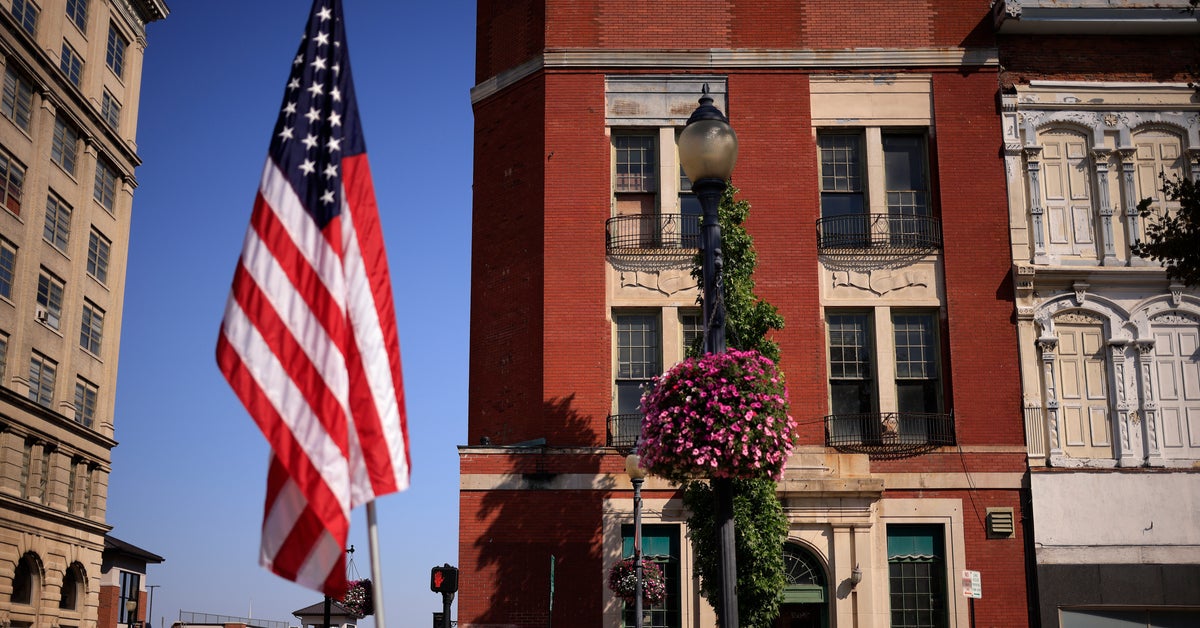[ad_1]
As racist right-wing governing bodies attempt to erase teaching the truth about this country’s birth and growth that were sustained by enslaving Black people, it’s important to mark an historic date in that history: the Jamestown landing on Aug. 20, 1619, and The New York Times’ ambitious and award-winning “The 1619 Project,” launched on the 400th anniversary in 2019.
While slavery here actually began earlier, “The 1619 Project” brought enslavement back into the mainstream discussion, which has only intensified over the past four years. Such debates—as well as the pure BS being spewed in support of Florida’s claims of slavery’s “benefits” to those in bondage—got me thinking about the music that tells the story of the brutal voyages here, and the fates that befell enslaved Africans and their descendants once—or if—they arrived.
RELATED STORY: Who’s afraid of the 1619 Project?
Black Music Sunday is a weekly series highlighting all things Black music. With 170 stories (and counting) covering performers, genres, history, and more, each featuring its own vibrant soundtrack, I hope you’ll find some familiar tunes and perhaps an introduction to something new.
One of the most powerful pieces of music to tell the story of the ships bringing enslaved Africans here through the Middle Passage was sung by an unlikely group of R&B musicians and childhood friends: The O’Jays. In 2021, Otis Alexander profiled the group for Black Past.
The O’Jays, an R&B ensemble from Canton, Ohio, was formed in 1958 by childhood friends Eddie Levert, who was born in Bessemer, Alabama in 1942 and moved to Canton at the age of 8, and Walter Williams, Sr. born in Canton in 1942. They became best friends and a singing duet in 1958. The duo invited other schoolmates who could sing, William Powell, born in Canton in 1942; Bobby Massey, born in Canton in 1942; and Bill Isles, born in 1941 in McAntenville, North Carolina, also joined. The five, all of whom attended McKinley High School in Canton, first called themselves the Triumphs but in 1960 they changed their name to the Mascots. In 1961, The Mascots released a single, “Miracles,” on the Cincinnati-based King label. Their song was actively promoted by Eddie O’Jay, a popular disc jockey in Cleveland, Ohio. As a tribute to him, they in 1963 rename themselves the O’Jays.
[…]
Kenny Gamble & Leon A. Huff signed the O’Jays to their Philadelphia International label in 1972 and there they had their first and only million-selling single, “Back Stabbers” which reached #1 on the R&B chart and no. #3 pop on the US Billboard Hot 100 later that year. In 1973, their hit “Love Train” followed, peaking at #9 on the R&B chart. Unusual for an R&B song, the lyrics of “Love Train” promoted global unity. While not as successful as “Back Stabbers,” it went gold, selling more than 500,000 copies. Many music critics considered it the birth of Philadelphia-style soul music.
In late 1973, the O’Jays built upon the “Back Stabbers” success with a hit album entitled “Ship Ahoy.” However, the titular song, written by Gamble and Huff, got very little radio airplay—in no small part because it was nearly 10 minutes long!
Allen Castle of the “10 Minute Record Reviews” YouTube channel covers the background of the record—including bits about its production, Gamble and Huff, and the O’Jays.
Give a listen to the chilling “Ship Ahoy.”
Professor Sasha Panaram wrote “’Ship Ahoy’: The Sounds of Slavery” for the 2014 Black Atlantic seminar at Duke University.
The song, “Ship Ahoy,” itself is unlike anything of its time. First off, “Ship Ahoy” is nine minutes and forty seconds long – three times the length of any song typically produced today or even in the 1970s. The first voice of the song that appears roughly forty-seconds after the song begins is that of a long drawn out groan or sigh. Prior to this voice, listeners sense they are on a ship after hearing sounds resembling strong winds, splashing water, wooden creaks, and thunderous storms. When the O’Jays start singing their lyrics describe the people onboard – “men, women, and baby slaves” – and their journey to the “land of liberty” where “life’s design is already made.” As the O’Jays sing of the tiring journey across the Atlantic, the only constant in the slaves’ lives is the sun that beats down on them. By the end of the song, the O’Jays initial description of the “land of liberty” becomes a “jail” – an unpromising destination where slaves are beaten, exploited for labor, and forever subordinate to their masters.
While the lyrics of “Ship Ahoy” tell of the exhaustive journey of the Middle Passage and the slaves arrival in the Americas, the silences of the song are equally important. The long gaps and pauses apparent throughout the song and especially at the beginning reflect the waiting that the slaves endured as they were shipped from one location to another. Although the long pause at the start of the song is unsettling to listeners since we are used to hearing words shortly after the music begins, the silence attempts to replicate in listeners the feeling of uncertainty in slaves who embarked on journeys with very few details, if any, about their impending trips. The one phrase used the most in the O’Jays song is “Ship Ahoy.” “Ship Ahoy” is the phrase the O’Jays belt out between verses. While the exact origin of this phrase is unknown, “Ship Ahoy” was generally used by sailors to both greet ships and announce their presence. That the O’Jays choose to not only name their song “Ship Ahoy,” but also repeat the phrase excessively throughout the song suggests their desire to call attention to the hundreds upon thousands of ships that facilitated the Middle Passage.
Lyrics:
Ship Ahoy! Ship Ahoy! Ship Ahoy! Ship Ahoy!
Ship Ahoy, yeah
Ship Ahoy! Ship Ahoy! Ship Ahoy! Ship Ahoy!
Ship AhoyAs far as your eyes can seeMen, women, and baby slavesComing to the land of LibertyWhere life’s design is already madeSo young and so strongThey’re just waiting to be saved…Lord, I’m so tiredAnd I know you’re tired tooLook over the horizon, see the sunShining down on you…
Ship Ahoy! Ship Ahoy! Ship Ahoy! Ship Ahoy!Ship Ahoy, yeahShip Ahoy! Ship Ahoy! Ship Ahoy! Ship Ahoy!Ship Ahoy. uh-huh
Can’t you feel the motion of the oceanCan’t you feel the cold wind blowing by?There’s so many fish in the sea
We’re just, we’re just, we’re just
We’re just masts?
Riding on the waves…
The waves
We are
Riding on the waves…Ship Ahoy! Ship Ahoy! Ship Ahoy! Ship Ahoy!Ship Ahoy, now yeahShip Ahoy! Ship Ahoy! Ship Ahoy! Ship Ahoy!
They’re coming by the hundredsComing by the thousands, tooLook over the horizon, see the sunShining down on you…
Ship Ahoy! Ship Ahoy! Ship Ahoy! Ship Ahoy!My-yyyShip Ahoy! Ship Ahoy! Ship Ahoy! Ship Ahoy!Ship Ahoy! Ship Ahoy! Ship Ahoy! Ship Ahoy!Ship Ahoy! Ship Ahoy! Ship Ahoy! Ship Ahoy!
We’re just, we’re just, we’re justWe’re just masts?Riding on the waves…The wavesWe areRiding on the waves…
Ship Ahoy! Ship Ahoy! Ship Ahoy! Ship Ahoy!
Ship Ahoy! Ship Ahoy! Ship Ahoy! Ship Ahoy!
Ship Ahoy! Ship Ahoy! Ship Ahoy! Ship Ahoy!
Ship Ahoy! Ship Ahoy! Ship Ahoy! Ship Ahoy!
Ship Ahoy! Ship Ahoy! Ship Ahoy! Ship Ahoy!
Ship Ahoy! Ship Ahoy! Ship Ahoy! Ship Ahoy!
Ship Ahoy! Ship Ahoy! Ship Ahoy! Ship Ahoy!
Ship Ahoy! Ship Ahoy! Ship Ahoy! Ship Ahoy!
Ship Ahoy! Ship Ahoy! Ship Ahoy! Ship Ahoy!
Ship Ahoy! Ship Ahoy! Ship Ahoy! Ship Ahoy!
Ship Ahoy! Ship Ahoy! Ship Ahoy! Ship Ahoy!
Ship Ahoy! Ship Ahoy! Ship Ahoy! Ship Ahoy!Totin’ that barge, lift that bailGet a little something, gonna land in jailSomebody bite the whipI’m your masterAnd you’re my slaveUh-huhAnd you’re my slaveI’m your masterLook over there, what do you seeTell him look over here, what do you see
Born Asa Bundy Sheffey on August 4, 1913, Robert Hayden was raised in the Detroit neighborhood Paradise Valley. He had an emotionally tumultuous childhood and lived, at times, with his parents and with a foster family. In 1932, he graduated from high school and, with the help of a scholarship, attended Detroit City College (later, Wayne State University). In 1944, Hayden received his graduate degree from the University of Michigan.
Hayden published his first book of poems, Heart-Shape in the Dust (Falcon Press), in 1940, at the age of twenty-seven. He enrolled in a graduate English literature program at the University of Michigan, where he studied with W. H. Auden. Auden became an influential and critical guide in the development of Hayden’s writing. Hayden admired the work of Edna St. Vincent Millay, Elinor Wiley, Carl Sandburg, and Hart Crane, as well as the poets of the Harlem Renaissance—Langston Hughes, Countee Cullen, and Jean Toomer. He had an interest in African American history and explored his concerns about race in his writing. Hayden ultimately authored nine collections of poetry during his lifetime, as well as a collection of essays, and some children’s literature. Hayden’s poetry gained international recognition in the 1960s, and he was awarded the grand prize for poetry at the First World Festival of Negro Arts in Dakar, Senegal in 1966 for his book Ballad of Remembrance (Paul Breman, 1962).
During and after the Middle Passage, many of the enslaved Africans from areas around Benin, and those who later embraced the faith of Vodou after arriving in the New World, called down curses on their enslavers. One of the most powerful deities in the Vodou pantheon is the Lwa Damballah: the Sky Father.
Bahamian folk musician Exuma wrote and recorded this song to Dambala in 1970, and Nina Simone covered it in 1974. It is one of Simone’s most powerful songs, if still not very well-known, half a century later.
Listening to her rendition makes the hair on my arms stand up.
Lyrics:
Oh Dambala, come DambalaOh Dambala, come DambalaThink of the wings of a three-toed frogEat weeds from the deepest part of seaOh Dambala, come DambalaOh Dambala, come Dambala
On the seventh day, God will be thereOn the seventh night, satan will be thereOn the seventh day, God will appearOn the seventh night, satan will be thereYou slavers will knowWhat it’s like to be a slaveSlave to your heartSlave to your soulOh Dambala, come DambalaOh Dambala, come Dambala
You slavers will knowWhat it’s like to be a slaveSlave to your mindSlave to your raceYou won’t go to heavenYou won’t go to hellYou remain in your gravesWith the stench and the smellOh Dambala, come DambalaOh Dambala, come Dambala
Enslaved women were often faced with the agony of having their children sold and sent away from them, many of those children born out of rape. In 2017’s “At the Purchaser’s Option,” Grammy award-winning folksinger, musician, and music historian Rhiannon Giddens sings the story of one of those women.
From the video’s YouTube notes:
“Last year I came across an advertisement from the 1830s for a young woman; thinking about her, and how she had to maintain her humanity against horrific odds inspired this song named for the end of the ad: ‘She has with her a 9-month old baby, who is at the purchaser’s option.” — Rhiannon
At the Purchaser’s Option (Rhiannon Giddens/Joey Ryan)
I have a babe but shall I keep him’Twill come the day when I’ll be weepin’But how can I love him any lessThis little babe upon my breast
You can take my bodyYou can take my bonesYou can take my bloodBut not my soul
I’ve got a body dark and strongI was young but not for longYou took me to bed a little girlLeft me in a woman’s world
Day by day I work the lineEvery minute overtimeFingers nimble, fingers quickMy fingers bleed to make you rich
As enslaved people adopted the religion of their enslavers, they often used their permitted Sunday gathering to sing spiritual and gospel songs—songs that carried messages, hopes, dreams, and plans to escape to freedom.
RELATED STORY: Black music is Black history: Our spirituals
One of those such songs was “Old Ship of Zion,” sung below by Dr. Bernice Johnson Reagon, civil rights activist, ethnomusicologist, and founder of the music group Sweet Honey In The Rock.
In the liner notes of her 1975 album” Give Your Hands to Struggle,” Reagon wrote:
“’The Old Ship of Zion,’ a spiritual and gospel hymn, is also associated with the culture of the 19th century Underground Railroad. A congregational singing of this song goes on for many verses as the singers build it together. You can add as many verses as you like about this image of a ship bringing hope and life, set against the memory of that other ship of slavery and death. The song has probably remained so important because of its connection to those of us who are living evidence of having survived the experience.”
Give it a listen.
When I think of songs providing a roadmap for those running toward freedom, I always think of “Follow the Drinking Gourd,” though on a website devoted to the song, music researcher Joel Bresler challenges that notion.
The Drinking Gourd song was supposedly used by an Underground Railroad operative to encode escape instructions and a map. These directions then enabled fleeing slaves to make their way north from Mobile, Alabama to the Ohio River and freedom.
[…]
Much of the Drinking Gourd’s enduring appeal derives from its perceived status as a unique, historical remnant harkening back to the pre-Civil War South – no other such map songs survive. But re-examining the Drinking Gourd song as history rather than folklore raises many questions.
No matter the history, my favorite version was sung by folk singer Richie Havens, which he recorded in 1991.
I’m closing this week’s installment with a tribute to the escape to freedom led by Harriet Tubman. Actress and singer Cynthia Erivo wrote and performed “Stand Up” for the 2019 movie “Harriet.”
Lyrics:
I been walkin’With my face turned to the sunWeight on my shouldersA bullet in my gunOh, I got eyes in the back of my headJust in case I have to runI do what I can when I can while I can for my peopleWhile the clouds roll back and the stars fill the night
That’s when I’m gonna stand up
Take my people with me
Together we are going
To a brand new home
Far across the river
Can you hear freedom calling?
Calling me to answer
Gonna keep on keepin’ onI can feel it in my bones
Early in the mornin’Before the sun begins to shineWe’re gonna start movin’Towards that separating lineI’m wadin’ through muddy watersYou know I got a made up mindAnd I don’t mind if I lose any blood on the way to salvationAnd I’ll fight with the strength that I got until I die
So I’m gonna stand upTake my people with meTogether we are goingTo a brand new homeFar across the riverCan you hear freedom calling?Calling me to answerGonna keep on keepin’ on
And I know what’s around the bendMight be hard to face ’cause I’m aloneAnd I just might failBut Lord knows I triedSure as stars fill up the sky
Stand upTake my people with meTogether we are goingTo a brand new homeFar across the riverCan you hear freedom calling?Calling me to answerGonna keep on keepin’ on
I’m gonna stand upTake my people with meTogether we are goingTo a brand new homeFar across the riverDo you hear freedom calling?Calling me to answerGonna keep on keepin’ on
I’m gonna stand up
Take my people with me
Together we are going
To a brand new home
Far across the river
I hear freedom calling
Calling me to answer
Gonna keep on keepin’ onI can feel it in my bones
I go to prepare a place for youI go to prepare a place for youI go to prepare a place for youI go to prepare a place for you
This song evokes strong feelings in me personally: It reminds me of my mom’s great aunt Sally, who escaped from enslavement in Loudoun County, Virginia, at age 15, walking all the way to freedom and “a brand new home” in Canada.
Please join me in the comments for more music, and as always, I hope you will post songs that helped you learn the stories of enslavement.
[ad_2]
Source link





















